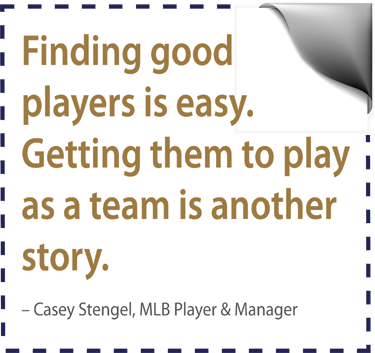Curricula for Building Highly A Productive Team
High functioning teams are one of the most valuable assets an organization can have.
These groups perform above average in objective metrics, as well as in areas that are subjective and not as easily quantified or measured.
How do you know if a team is functioning at it's highest level?
There are two primary areas of measurement: the first is objective or quantifiable and the second more subjective.
Objective metrics are the areas that are typically measured for the functional areas and could include one or more of the following: quality, speed of service, profitability, revenue generation, customer satisfaction scores, or something beyond these examples that is specific to an organization or industry.
Subjective areas are less tangible and include: team members’ sense of belonging, sense of job satisfaction, sense or purpose for the job, self-motivation, the camaraderie amongst team members, and the culture or environment.
Teams that work well are energizing and motivating for their members.
On high functioning teams, the members experience a feeling of contentment, juxtaposed by a “creative tension” that is the by-product of continuously striving to work better as a team to ever better results.
The team also creates an environment of personal responsibility where all members are accountable to each other and the team as a whole.
How does a team get to be high functioning?
Most of the high functioning teams that have been studied were not created by happenstance. Rather, the teams engaged in a strategic, targeted development process over a period of time, which led to them achieving above average results.
These strategies are not complex. They do, however, require thoughtful process facilitation. And this is where we fit it.
Our Social Synergetics Model for Creating High Functioning teams provides the structure and our expert facilitators guide the process.
You'll be amazed and delighted with the results we can help you get.
Truly.
Find out more.
These groups perform above average in objective metrics, as well as in areas that are subjective and not as easily quantified or measured.
How do you know if a team is functioning at it's highest level?
There are two primary areas of measurement: the first is objective or quantifiable and the second more subjective.
Objective metrics are the areas that are typically measured for the functional areas and could include one or more of the following: quality, speed of service, profitability, revenue generation, customer satisfaction scores, or something beyond these examples that is specific to an organization or industry.
Subjective areas are less tangible and include: team members’ sense of belonging, sense of job satisfaction, sense or purpose for the job, self-motivation, the camaraderie amongst team members, and the culture or environment.
Teams that work well are energizing and motivating for their members.
On high functioning teams, the members experience a feeling of contentment, juxtaposed by a “creative tension” that is the by-product of continuously striving to work better as a team to ever better results. The team also creates an environment of personal responsibility where all members are accountable to each other and the team as a whole.
What makes teams high-functioning?
Teams that work really well are:- Self-correcting/self-regulating – Have a code of conduct that allows the team to confront any situation that arises in a productive, effective and efficient manner.
- Self-directed – Set and achieve goals that are ever more challenging.
- Structured for conflict and agreement management – Understand conflict is a necessary aspect of healthy teams and manage conflict.
- Committed to processes for effectiveness – Establish protocols designed to regularly challenge and assess legacy processes for effectiveness.
- Focused on continuous improvement – Continuously work towards process improvement and innovation.
- Propelled by a culture of individual and group growth – Actively support on-going personal/professional growth and development.
How does a team get to be high functioning? 
Most of the high functioning teams that have been studied were not created by happenstance. Rather, the teams engaged in a strategic, targeted development process over a period of time, which led to them achieving above average results.These strategies are not complex. They do, however, require thoughtful process facilitation. And this is where we fit it.
Our Social Synergetics Model for Creating High Functioning teams provides the structure and our expert facilitators guide the process.
You'll be amazed and delighted with the results we can help you get.
Truly.
Find out more.


